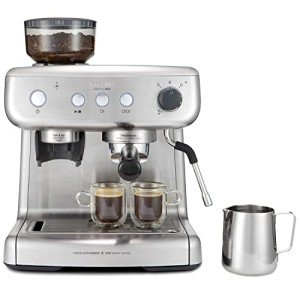The Rise of Home Espresso Machines: A Comprehensive Guide
As coffee fans continue to seek fresh and tasty brews in the house, the popularity of home espresso machines has surged in the last few years. No longer simply the domain of coffee shops and coffeehouse, these machines empower people to craft barista-quality espresso beverages from the convenience of their kitchen areas. This short article will check out the various types of home espresso machines, their features, and considerations for choosing the best one. Furthermore, it will offer a choice of FAQs to help potential purchasers make notified choices.
Kinds Of Home Espresso Machines
Home espresso machines can be classified into a number of classifications based on their mechanisms and user-friendliness. Each type has its special functions, pros, and cons.
| Type | Description | Pros | Cons |
|---|---|---|---|
| Manual Espresso Machines | Needs the user to by hand manage the developing procedure, including techniques like pulling a lever to create pressure. | - Complete control over brewing process - Compact design | - Requires ability and practice - Time-consuming |
| Semi-Automatic Machines | Machine automates water circulation and pressure, however the user still controls the dosing and period of the brewing procedure. | - Balance of automation and control - Versatile | - Learning curve for improving methods |
| Completely Automatic Machines | Automates the whole brewing process, from grinding to developing, often with programmable settings for personalized beverages. | - Extremely user-friendly - Quick and hassle-free | - Less control over the developing process - Higher rate point |
| Pill or Pod Machines | Uses pre-packaged espresso capsules or pods to produce coffee quickly and quickly. | - Extremely simple to use - Minimal clean-up | - Limited flavor variety - More expensive per cup than ground coffee |
| Super-Automatic Machines | Integrates functions of fully automatic machines with built-in grinders, allowing users to brew whole bean espresso and milk-based beverages with one touch. | - All-in-one benefit - Ideal for milk-based drinks | - Often the most pricey - Can be large |
Functions to Consider
When picking a home espresso machine, potential buyers must think about the following features to guarantee they pick a machine that fulfills their requirements:
Grinder Type:
- Built-in grinders can offer fresher premises however might require more upkeep.
- Separate grinders permit more personalization of grind size.
Pressure:
- Look for machines that produce a minimum of 9 bars of pressure, which is ideal for developing espresso.
Water Temperature Control:
- Machines with adjustable temperature settings allow for much better extraction of flavor from beans.
Milk Frothing Options:
- Consider whether you desire a manual steam wand for frothing or an automatic milk frother for convenience.
Reduce of Cleaning:
- Machines with removable parts and self-cleaning functions considerably reduce clean-up time.
Size and Design:
- Ensure the machine fits easily in your cooking area and lines up with your aesthetic choices.
Budget:
- Set a budget before beginning your search, as prices can range substantially from affordable models to high-end machines.
Benefits of Home Espresso Machines
Owning a home espresso machine uses many benefits:
- Cost-Effective: Over time, developing espresso in your home can save coffee lovers money compared to frequent café sees.
- Customization: Users can try out different beans, grind sizes, and developing strategies to discover their ideal cup.
- Convenience: The capability to brew espresso any time gets rid of the requirement to head out to a café, especially useful during late nights or mornings.
- Quality assurance: With a home machine, people have total control over the quality of active ingredients and brewing processes.
Downsides of Home Espresso Machines
However, there are some disadvantages to think about:
- Initial Investment: High-quality espresso machines can be costly, needing a considerable in advance investment.
- Knowing Curve: Mastering the art of espresso developing can take some time and practice, which might be intimidating for novices.
- Upkeep: Like any home appliance, espresso machines require regular cleansing and upkeep to ensure optimal efficiency.
FAQs
1. What is the best type of home espresso machine for beginners?
Response: For beginners, a semi-automatic machine is typically suggested as it offers a balance between control and automation, allowing you to find out the fundamentals without overwhelming intricacy.
2. How much should I invest on a home espresso machine?
Answer: Entry-level machines can start around ₤ 100 to ₤ 300, while higher-end models can vary from ₤ 500 to over ₤ 2000. It's vital to set a budget based upon your expected use and preferred functions.
3. Do I require a different grinder?
Response: While some espresso machines feature built-in grinders, buying a different grinder enables greater modification and guarantees better quality premises.
4. How frequently should I clean my espresso machine?
Response: Cleaning frequency can vary by machine type, however it's usually advised to clean up the machine after each use and carry out deep cleansings weekly or monthly, depending upon usage.
5. Can I make milk-based beverages with any espresso machine?
Answer: Not all machines include milk frothing capabilities. If you delight in beverages like lattes or coffees, try to find a machine with a steam wand or automatic frother.
Home espresso machines are transforming the way coffee enthusiasts enjoy their beloved brews. With different types and advanced features readily available in the market, there is something for everybody. Whether it's the pleasure of creating special dishes or just appreciating the perfect shot of espresso, investing in a home espresso machine can improve both the coffee-drinking experience and the quality of life for coffee lovers everywhere. Just like Portable Espresso Machines , it is important to weigh the advantages against the possible downsides and select a machine that effortlessly fits both your way of life and preferences.

